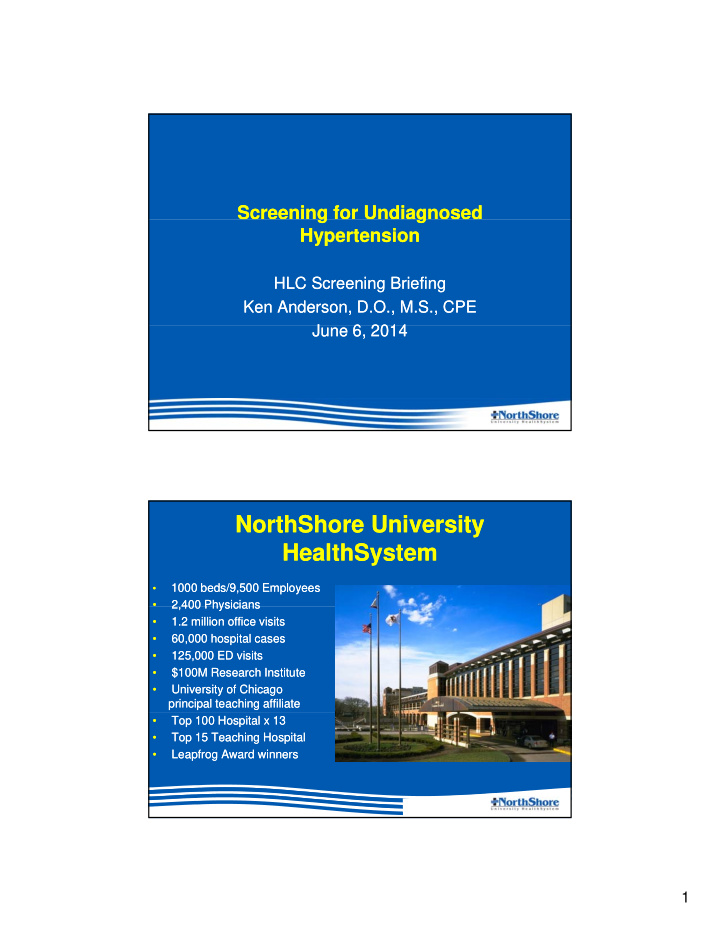



Screening for Undiagnosed Screening for Undiagnosed g g g g Hypertension Hypertension HLC Screening Briefing HLC Screening Briefing Ken Anderson, D.O., M.S., CPE Ken Anderson, D.O., M.S., CPE J June 6, 2014 June 6, 2014 J 6 2014 6 2014 NorthShore University NorthShore University HealthSystem HealthSystem • 1000 beds/9,500 Employees 1000 beds/9,500 Employees • 2 400 Physicians 2,400 Physicians 2 400 Physicians 2,400 Physicians • 1.2 million office visits 1.2 million office visits • 60,000 hospital cases 60,000 hospital cases • 125,000 ED visits 125,000 ED visits • $100M Research Institute $100M Research Institute • University of Chicago University of Chicago principal teaching affiliate principal teaching affiliate • Top 100 Hospital x 13 Top 100 Hospital x 13 • Top 15 Teaching Hospital Top 15 Teaching Hospital • Leapfrog Award winners Leapfrog Award winners 1
Hypertension Screening Importance Hypertension Screening Importance • Prevalent: affects 30% of Americans > 18 Prevalent: affects 30% of Americans > 18 yrs yrs • Leading modifiable risk factor for: Leading modifiable risk factor for: Leading modifiable risk factor for: Leading modifiable risk factor for: – Coronary Artery Disease Coronary Artery Disease – Stroke Stroke – Congestive Heart Failure Congestive Heart Failure – Chronic Kidney Disease Chronic Kidney Disease • Annual cost in medical care for these Annual cost in medical care for these Annual cost in medical care for these Annual cost in medical care for these diseases and lost productivity: $338.2 billion diseases and lost productivity: $338.2 billion • 29% of hypertensive patients are unaware 29% of hypertensive patients are unaware Why Hypertensive Americans Are Unaware Why Hypertensive Americans Are Unaware • Screening protocols are present but largely Screening protocols are present but largely NOT followed by patients. NOT followed by patients. y p y p • Variability in BP readings is distracting to Variability in BP readings is distracting to patients AND providers. patients AND providers. • “Gold Standard” ambulatory BP monitoring is “Gold Standard” ambulatory BP monitoring is not well not well- -tolerated and widely unavailable. tolerated and widely unavailable. • Physician and patient reluctance to “label” Physician and patient reluctance to label Physician and patient reluctance to “label” Physician and patient reluctance to label patients as “hypertensive”. patients as “hypertensive”. 2
The Billion(s) Dollar Question The Billion(s) Dollar Question • Can we identify patients who are at high • Can we identify patients who are at high Can we identify patients who are at high Can we identify patients who are at high risk for complications of hypertension risk for complications of hypertension using stratified screening methods that using stratified screening methods that rely on the electronic medical record rely on the electronic medical record and data analytics as enablers? and data analytics as enablers? Overview of the Program Overview of the Program • BP readings automatically entered from EMR into BP readings automatically entered from EMR into NorthShore Data Warehouse. NorthShore Data Warehouse. • Algorithms created to weave data points into Algorithms created to weave data points into probability index for diagnosis. probability index for diagnosis. • Patient Portal and telephonic outreach promote Patient Portal and telephonic outreach promote advanced screening for index patients. advanced screening for index patients. • Automated office blood pressure recordings Automated office blood pressure recordings p p g g confirm or refute diagnosis. confirm or refute diagnosis. • Identified patients enter treatment protocols. Identified patients enter treatment protocols. 3
Results From Intervention Results From Intervention • Rate of unidentified patients decreased from 14% Rate of unidentified patients decreased from 14% to 8% over first 18 months of program. to 8% over first 18 months of program. p p g g • 1,586 patients identified through algorithms as 1,586 patients identified through algorithms as having putative hypertension. having putative hypertension. • 1/3 of these patients had advanced screening. 1/3 of these patients had advanced screening. • 38.5% of advanced screening patients had verified 38.5% of advanced screening patients had verified diagnosis 41 5% had relevant “pre diagnosis 41 5% had relevant “pre-hypertension” diagnosis, 41.5% had relevant pre diagnosis, 41.5% had relevant pre hypertension hypertension” hypertension • 50 50- -75 newly diagnosed patients each month 75 newly diagnosed patients each month referred for lifestyle modification or treatment. referred for lifestyle modification or treatment. Conclusions Conclusions • EMR and advanced analytics provides a EMR and advanced analytics provides a useful adjunct to improve screening and useful adjunct to improve screening and j j p p g g recognition of hypertension. recognition of hypertension. • Patients and Providers found the screening Patients and Providers found the screening program to be successful and desirable. program to be successful and desirable. • Prevention of secondary vascular conditions Prevention of secondary vascular conditions will provide reduction in health care expense. will provide reduction in health care expense. p p p p 4
Recommend
More recommend